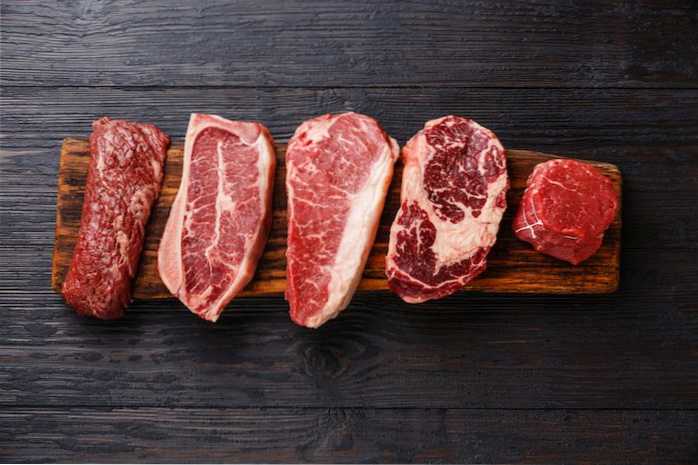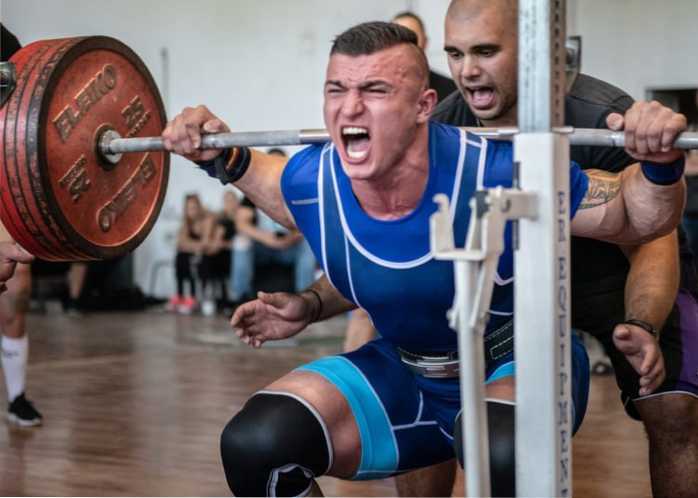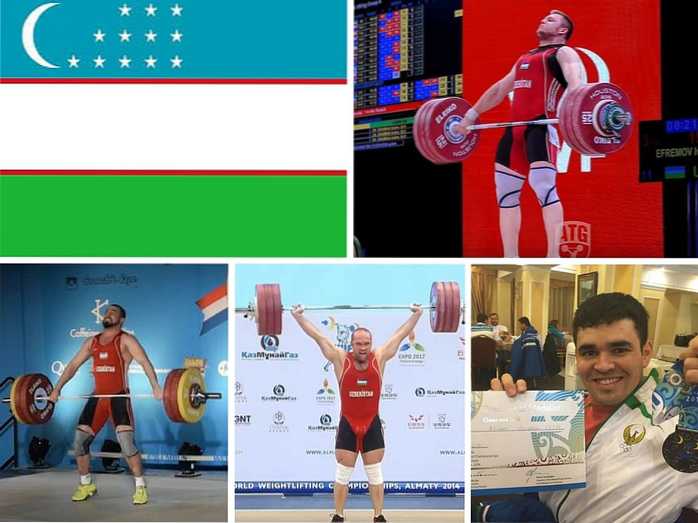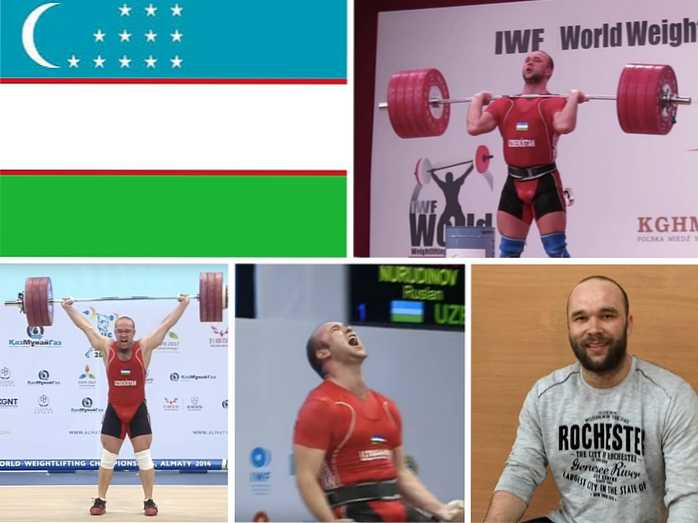
Leangains The Best Intermittent Fasting for Gaining Muscle?

Labeled as “The Birthplace of Intermittent Fasting,” we know that such titles are often exaggerated on the internet, but Leangains has a claim to the throne. This is where the popular 16/8 fasting method started for strength athletes.
Swedish model-turned-powerlifter and nutrition consultant Martin Berkhan launched his blog in the mid-2000s and in a time when bodybuilders and physique competitors were insisting on eating several small meals per day to stoke the metabolism, Berkhan had sliced down to 5.5 percent body fat while fasting daily.
Here we'll explore the dietary protocols as well as the workouts and supplements that guide Leangains.
- Intermittent Fasting
- Leangains Macronutrients
- Reverse Pyramid Training
- Supplements
- “The Leangains Study”
Editor's note: The content on BarBend is meant to be informative in nature, but it shouldn't take the place of advice and/or supervision from a medical professional. The opinions and articles on this site are not intended for use as diagnosis, prevention, and/or treatment of health problems. Speak with your physician if you have any concerns or before beginning any new dietary regimen.
View this post on InstagramA post shared by Martin Berkhan (@martinberkhan) on
Leangains and Intermittent Fasting
Berkhan's approach is best known for popularizing intermittent fasting. Fasting, of course, has been practiced for religious and health reasons for centuries, but Berkhan is the man who extolled it as a means for improving body composition and strength gains.
It's a 16/8 approach: followers fast for sixteen hours every day (inclusive of sleep) and eat during an eight-hour feeding window.
Berkhan cites reams of studies to support this approach - the purported benefits are:
Better insulin sensitivity and nutrient absorption.
Put simply, the body secretes insulin when you eat carbs or protein, and spiking insulin too much and too often - something to look out for if you eat a lot of refined carbs and not much protein - can desensitize the body to its effects. Becoming too “resistant” to insulin results in Type 2 diabetes, but taking breaks from eating is one way to reduce insulin spikes and help with insulin sensitivity, which may improve nutrient absorption and body composition.(1)(2)
Better fat metabolism
Some research has suggested that exercising while fasted produces greater fat metabolism when compared to fed training - you may burn more fat if you're lifting on an empty stomach.(3)(4) Fasting also appears to increase catecholamines (“stress” hormones like adrenaline) that are linked to increased fat oxidation.(5)(6)(7) Other studies have found that fasting may help with preserving muscle during weight loss, though there's not really a consensus here - plenty of research has found no difference when calories are equal.(8)(9)

Better muscle gain
The notion that not eating can help with muscle gain seems like heresy, but while overall calorie and macronutrient intake (more on that later) is by far the most important thing, some research has concluded that fasted weight training can produce an “anabolic rebound” effect, stimulating the muscle gain effect.(10) On a similar note, going without food (thereby keeping insulin low) may increase the body's production of growth hormone, which helps to retain muscle.(11)(12)
[Learn more: The complete guide to naturally boosting growth hormone.]
Less hunger
That old rule of “many small meals throughout the day” may make it harder to control appetite. This may be because of ghrelin, sometimes called “hunger's timekeeper.” The body seems to release it based on when you usually eat, so eating more frequently might increase hunger, while fewer meals might help you control it.(13)
Convenience
Even if you disagree with the preceding points - and again, we're not saying that every researcher or person who has tried fasting agrees with them - many aficionados of “IF” simply find it easier, more satisfying, and more convenient to eat one or two big meals instead of a lot of little, not-that-satisfying ones.

Leangains Macronutrients
- The diet involves tracking macronutrients, cycling carbs and calories, and eating very high protein
Berkhan is often at pains to emphasize that the approach is a lot more than simply not eating for most of the day. Your total calorie intake and what it comprises are fundamental to body composition, whether you fast or not.
To that end, Leangains has a pretty strict calorie and macronutrient model that could be seen as fitting the “If It Fits Your Macros” model: you work out your total daily energy expenditure (that's the amount of calories you burn in a day) and then you're prescribed a set amount of protein, carbs, and fat to fill those calories.
The diet is high in protein. Athletes in general typically eat more than the average person, ideally between 0.7 and 1 gram of protein per pound of bodyweight. Berkhan errs on a higher protein intake of about 1.1 to 1.4 grams of protein per pound, especially if you're trying to lose fat.
He does so because protein is very satiating and because of its thermic effect - you burn more calories digesting protein than the other macros, with some experts suggesting it should actually count for 3.2 calories per gram instead of the 4 calories per gram commonly cited.(14)(15)(16)
The total number of calories throughout the week is pretty standard: a deficit of 3,500 calories if you're looking to lose fat and a smaller surplus if you're trying to gain muscle.
But the diet emphasizes carb cycling: you eat more calories and carbs on workout days and fewer carbs and calories on rest days. This may help with insulin sensitivity, muscle gain, recovery, and appetite control.(17)(18)
[Read more in our complete guide to carb cycling!]
View this post on InstagramA post shared by Isabella von Weissenberg (@ivweissenberg) on
Leangains Workout
- Workouts are short, heavy, and focus on powerlifting movements
A powerlifter at heart - he deadlifts over triple his bodyweight, claims the unofficial world record for the seal row at 145 kilograms, and coaches world record holding powerlifter Isabella von Weissenberg - barbell training is a cornerstone of Leangains.
Berkhan takes private clients and prescribes workouts according to their needs, but the classic, widely circulated Leangains workout plan is extraordinarily simple and low volume: you work out three days per week and each is built around a powerlifting exercise.
Back day: Deadlift, overhead press, weighted chin ups, rows, bodyweight chin ups
Chest day: Bench press, incline dumbbell press, bicep curls, tricep extensions
Leg day: Squat, hamstring curl, leg extension, cable crunch, calf raises
View this post on InstagramA post shared by Martin Berkhan (@martinberkhan) on
Reverse Pyramid Training
Importantly, the workouts are designed with a reverse pyramid training protocol. One takes three warm-up sets at 40, 60, and 80 percent of the working weight, then there's a very heavy working set, typically 3 to 5 reps for the deadlift and 6 to 10 reps for all other exercises.
The weight is then decreased by 10 percent and, after resting three to five minutes, a second set is completed with one more rep than the first set. Repeat for a third set, then you're done. (Oftentimes only two sets are prescribed, particularly for deadlifts.)
Berkhan uses this method because he finds it the most time efficient and points to studies that have seen similar benefits from more sets and reps.(19) He notes on his site that this may not be the best way to train for competitive powerlifting, but for the average person looking to gain strength, build muscle, lose fat, and save time, he considers it unparalleled.
If possible, he advises having a small meal (your “break fast”), training an hour or two later, then eating the bulk of your calories. If you're training fasted, he suggests taking supplementary amino acids.
Leangains Supplements
Essential Amino Acids
If you're training fasted, in the past Berkhan has recommended taking 15 grams of branched chain amino acids before training but these days prefers essential amino acids. These provide amino acids, the building blocks of protein, and may help to preserve muscle and improve performance.(20)(21)(22)
[See our list of the best BCAA supplements on the market!]
Fish Oil
Evidence suggests that these pills can help with inflammation, immunity, and maybe even muscle growth.(23)(24)(25)
[Curious? Take a look at our list of the best Omega-3 supplements.]
Creatine
Widely used, 5 to 10 grams per day increases muscle size and power output.(26)
[See our picks for the best creatine supplements.]

Calcium
If you're not consuming a lot of dairy or a lot of leafy greens, a calcium supplement can be helpful for bone health and Berkhan likes to cite studies showing it may increase fat excretion and boosts testosterone.(27)(28)
Vitamin D
Because the best source is sunlight, most people are low in this important nutrient that may influence immunity, bone health, testosterone, and athletic performance.(29)(30)(31)(32)
Glucosamine
This one is often taken as a means to reduce joint pain and may be useful, especially for older lifters.(33)

The “Leangains Study”
The best study published that combined 16/8 with heavy resistance training was published in The Journal of Transitional Medicine in 2016.(34)
It brought thirty-four men in their twenties and thirties who had been lifting consistently for at least five years and had them eat the same number of calories and macros over an eight-week training program. Some did 16/8 and some didn't, and they found that the group that fasted lost more fat, had better levels of blood sugar and triglycerides, and had more of the hormone adiponectin, which is involved in fatty acid breakdown and energy expenditure (and may explain the extra fat lost.)
The fasting group also had less testosterone and more cortisol, but those are normal things to occur when you're losing fat. It's a little tough to really know if the two groups really were eating precisely the same amount of calories but it's a promising study nonetheless, particularly as both groups ended the study with the same strength gains.
[See our complete breakdown of this fasting and powerlifting study!]
Wrapping Up
Today there are many forms of intermittent fasting, but Leangains is the original protocol that combines it with resistance training and controlled macronutrients to enhance performance and aesthetics.
We've just covered the basics here - Berkhan released a book, The Leangains Method, in 2019 if you want to learn more - but the short workouts and exacting diet have garnered success for a lot of people. If your goals are more sport specific or you're new to training and dieting, speak with a physician before undertaking any new regimen.
Featured image via Martin Berkhan on Facebook.
References
1. Halberg N, et al. Effect of intermittent fasting and refeeding on insulin action in healthy men. J Appl Physiol (1985). 2005 Dec;99(6):2128-36.
2. Horne BD, et al. Usefulness of routine periodic fasting to lower risk of coronary artery disease in patients undergoing coronary angiography. Am J Cardiol. 2008 Oct 1;102(7):814-819.
3. De Bock K, et al. Exercise in the fasted state facilitates fibre type-specific intramyocellular lipid breakdown and stimulates glycogen resynthesis in humans. J Physiol. 2005 Apr 15;564(Pt 2):649-60.
4. Cluberton LJ, et al. Effect of carbohydrate ingestion on exercise-induced alterations in metabolic gene expression. J Appl Physiol (1985). 2005 Oct;99(4):1359-63.
5. Palmblad J, et al. Effects of total energy withdrawal (fasting) on thelevels of growth hormone, thyrotropin, cortisol, adrenaline, noradrenaline, T4, T3, and rT3 in healthy males. Acta Med Scand. 1977 Jan;201(1-2):15-22.
6. Gotthardt JD, et al. Intermittent Fasting Promotes Fat Loss With Lean Mass Retention, Increased Hypothalamic Norepinephrine Content, and Increased Neuropeptide Y Gene Expression in Diet-Induced Obese Male Mice. Endocrinology. 2016 Feb;157(2):679-91.
7. Chan JL, et al. Short-term fasting-induced autonomic activation and changes in catecholamine levels are not mediated by changes in leptin levels in healthy humans. Clin Endocrinol (Oxf). 2007 Jan;66(1):49-57.
8. Varady KA. Intermittent versus daily calorie restriction: which diet regimen is more effective for weight loss? Send to Obes Rev. 2011 Jul;12(7):e593-601.
9. Catenacci VA, et al. A randomized pilot study comparing zero-calorie alternate-day fasting to daily caloric restriction in adults with obesity. Obesity (Silver Spring). 2016 Sep;24(9):1874-83.
10. Deldicque L, et al. Increased p70s6k phosphorylation during intake of a protein-carbohydrate drink following resistance exercise in the fasted state. Eur J Appl Physiol. 2010 Mar;108(4):791-800.
11. Ho KY, et al. Fasting enhances growth hormone secretion and amplifies the complex rhythms of growth hormone secretion in man. J Clin Invest. 1988 Apr;81(4):968-75.
12. Lanzi R, et al. Elevated insulin levels contribute to the reduced growth hormone (GH) response to GH-releasing hormone in obese subjects. Metabolism. 1999 Sep;48(9):1152-6.
13. LeSauter J, et al. Stomach ghrelin-secreting cells as food-entrainable circadian clocks. Proc Natl Acad Sci U S A. 2009 Aug 11;106(32):13582-7.
14. Westerterp-Plantenga MS. The significance of protein in food intake and body weight regulation. Curr Opin Clin Nutr Metab Care. 2003 Nov;6(6):635-8.
15. Halton TL, et al. The effects of high protein diets on thermogenesis, satiety and weight loss: a critical review. J Am Coll Nutr. 2004 Oct;23(5):373-85.
16. Livesey G. A perspective on food energy standards for nutrition labelling. Br J Nutr. 2001 Mar;85(3):271-87.
17. Coyle EF. Timing and method of increased carbohydrate intake to cope with heavy training, competition and recovery. J Sports Sci. 1991 Summer;9 Spec No:29-51; discussion 51-2.
18. McConell G, et al. Effect of timing of carbohydrate ingestion on endurance exercise performance. Med Sci Sports Exerc. 1996 Oct;28(10):1300-4.
19. Fisher JP, et al. A comparison of volume-equated knee extensions to failure, or not to failure, upon rating of perceived exertion and strength adaptations. Appl Physiol Nutr Metab. 2016 Feb;41(2):168-74.
20. Zheng L, et al. Effects of Supplementation of Branched-Chain Amino Acids to Reduced-Protein Diet on Skeletal Muscle Protein Synthesis and Degradation in the Fed and Fasted States in a Piglet Model. Nutrients. 2016 Dec 28;9(1). pii: E17.
21. Matthews DE. Observations of branched-chain amino acid administration in humans. J Nutr. 2005 Jun;135(6 Suppl):1580S-4S.
22. Jackman SR, et al. Branched-Chain Amino Acid Ingestion Stimulates Muscle Myofibrillar Protein Synthesis following Resistance Exercise in Humans. Front Physiol. 2017 Jun 7;8:390.
23. Simopoulos AP. Omega-3 fatty acids and athletics. Curr Sports Med Rep. 2007 Jul;6(4):230-6.
24. Ferrucci L, et al. Relationship of plasma polyunsaturated fatty acids to circulating inflammatory markers. J Clin Endocrinol Metab. 2006 Feb;91(2):439-46.
25. Smith GI, et al. Dietary omega-3 fatty acid supplementation increases the rate of muscle protein synthesis in older adults: a randomized controlled trial. Am J Clin Nutr. 2011 Feb;93(2):402-12.
26. Hespel P, et al. Ergogenic effects of creatine in sports and rehabilitation. Subcell Biochem. 2007;46:245-59.
27. Christensen R, et al. Effect of calcium from dairy and dietary supplements on faecal fat excretion: a meta-analysis of randomized controlled trials. Obes Rev. 2009 Jul;10(4):475-86.
28. Cinar V, et al. Testosterone levels in athletes at rest and exhaustion: effects of calcium supplementation. Biol Trace Elem Res. 2009 Summer;129(1-3):65-9.
29. Cannell JJ, et al. Athletic performance and vitamin D. Med Sci Sports Exerc. 2009 May;41(5):1102-10.
30. Tirabassi G, et al. Vitamin D and Male Sexual Function: A Transversal and Longitudinal Study. Int J Endocrinol. 2018 Jan 8;2018:3720813.
31. Pilz S, et al. Effect of vitamin D supplementation on testosterone levels in men. Horm Metab Res. 2011 Mar;43(3):223-5.
32. Wang N, et al. Vitamin D is associated with testosterone and hypogonadism in Chinese men: Results from a cross-sectional SPECT-China study. Reprod Biol Endocrinol. 2015 Jul 16;13:74.
33. Vangsness CT Jr, et al. A review of evidence-based medicine for glucosamine and chondroitin sulfate use in knee osteoarthritis. Arthroscopy. 2009 Jan;25(1):86-94.
34. Moro T, et al. Effects of eight weeks of time-restricted feeding (16/8) on basal metabolism, maximal strength, body composition, inflammation, and cardiovascular risk factors in resistance-trained males. J Transl Med. 2016 Oct 13;14(1):290.



Nimeni nu a comentat acest articol încă.